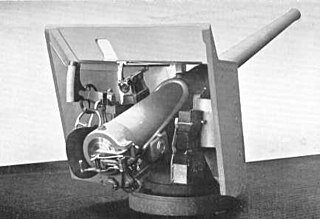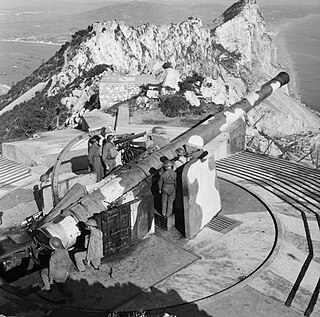
The QF 4.7-inch Gun Mks I, II, III, and IV were a family of British quick-firing 4.724-inch (120 mm) naval and coast defence guns of the late 1880s and 1890s that served with the navies of various countries. They were also mounted on various wheeled carriages to provide the British Army with a long range gun. They all had a barrel of 40 calibres length.

The QF 6-inch 40 calibre naval gun (Quick-Firing) was used by many United Kingdom-built warships around the end of the 19th century and the start of the 20th century.

The QF 12-pounder 12-cwt gun (Quick-Firing) was a common, versatile 3-inch (76.2 mm) calibre naval gun introduced in 1894 and used until the middle of the 20th century. It was produced by Armstrong Whitworth, Elswick and used on Royal Navy warships, exported to allied countries, and used for land service. In British service "12-pounder" was the rounded value of the projectile weight, and "12 cwt (hundredweight)" was the weight of the barrel and breech, to differentiate it from other "12-pounder" guns.

The Ordnance QF Hotchkiss 6 pounder gun Mk I and Mk II or QF 6 pounder 8 cwt were a family of long-lived light 57 mm naval guns introduced in 1885 to defend against new, small and fast vessels such as torpedo boats and later submarines. There were many variants produced, often under license which ranged in length from 40 to 58 calibers, but 40 caliber was the most common version.

The BL 12 inch naval gun Mk I was a British rifled breech-loading naval gun of the early 1880s intended for the largest warships such as battleships and also coastal defence. It was Britain's first attempt to match the large guns being installed in rival European navies, particularly France, after Britain transitioned from rifled muzzle-loading guns to the modern rifled breech-loaders somewhat later than the European powers. Mks I - VII all had a barrel of approximately 303 inches in length and similar performance.

The BL 13.5 inch naval gun Mk I was Britain's first successful large breechloading naval gun, initially designed in the early 1880s and eventually deployed in the late 1880s. Mks I - IV were all of 30 calibres length and of similar construction and performance.

The BL 12-inch Mark VIII naval gun was one of the first large British rifled breech-loading naval guns designed for the higher pressures generated by the new cordite propellant of the 1890s, and Britain's first large wire-wound gun. It represented a major advance compared to previous British guns.

The BL 9.2-inch Mk IX and Mk X guns were British breech loading 9.2-inch (234 mm) guns of 46.7 calibre, in service from 1899 to the 1950s as naval and coast defence guns. They had possibly the longest, most varied and successful service history of any British heavy ordnance.

The BL 9.2-inch Mk I–VII guns were a family of early British heavy breechloading naval and coast defence guns in service from 1881 to the end of World War I. They were originally designed to use the old gunpowder propellants.

The BL 6-inch gun Marks II, III, IV and VI were the second and subsequent generations of British 6-inch rifled breechloading naval guns, designed by the Royal Gun Factory in the 1880s following the first 6-inch breechloader, the relatively unsuccessful BL 6-inch 80-pounder gun designed by Elswick Ordnance. They were originally designed to use the old gunpowder propellants but from the mid-1890s onwards were adapted to use the new cordite propellant. They were superseded on new warships by the QF 6-inch gun from 1891.

The QF 4-inch gun Mks I, II, III were early British QF (quick-firing) naval guns originating in 1895. They all had barrels of 40 calibres length.

The BL 8 inch guns Mark I to Mark VII were the first generations of British rifled breechloaders of medium-heavy calibre. They were initially designed for gunpowder propellants and were of both 25.5 and 30 calibres lengths.

The BL 4-inch gun Mk I – Mk VI were a family of early British breech-loading 4-inch naval guns.

The BL 6 inch gun Mk V was an early Elswick Ordnance Company breech-loading naval gun originally designed to use the old gunpowder propellants. They were used for coast defence around the British Empire.

The BL 5-inch guns Mk I – Mk V were early British 5-inch rifled breechloading naval guns after it switched from rifled muzzle-loaders in the late 1870s. They were originally designed to use the old gunpowder propellants. The 5-inch calibre was soon discontinued in favour of QF 4.7-inch.

The BL 7.5-inch Mk II–Mk V guns were a variety of 50-calibre naval guns used by Britain in World War I. They all had similar performance and fired the same shells.

The BL 14 inch 45 calibre gun were various similar naval guns designed and manufactured by Elswick Ordnance Company to equip ships that Armstrong-Whitworth built and/or armed for several countries before World War I.

The QF 4.7 inch Gun Mark V originated as a 4.7 in (120 mm) 45-calibre naval gun designed by the Elswick Ordnance Company for export customers and known as the Pattern Y.

The RML 12.5-inch guns were large rifled muzzle-loading guns designed for British battleships and were also employed for coast defence.
This page is based on this
Wikipedia article Text is available under the
CC BY-SA 4.0 license; additional terms may apply.
Images, videos and audio are available under their respective licenses.



















